Abstract
Well-being is the condition of achieving happiness and harmony in personal development. We think that a person achieves well-being when he realizes his life goals, which is self-realization. When determining the range of personal goals, we use financial, social, physiological and psychological classification criteria. In our study, we propose a method of SWOT-analysis for individuals in order to form a matrix of activities for achieving the objectives of the individual within the context of the classification of goals. The method that we developed, which allows the determination of strengths and weaknesses of individuals, will help us to evaluate the external opportunities and threats in connection with the stated goals, as well as to develop a strategy of individual efforts for achieving these goals while taking into account the data before the analysis. Our proposed method can be used by management to assess compliance with the objectives of employee personal goals of the company. Parents of students, graduates can use the SWOT-analysis to assist in the selection of the future direction of a child's education.
Keywords: Well-beingSWOT-analysisPersonal SWOT-analysisSWOT matrix
Introduction
Every person has his own goals and objectives in life. Some people deliberately try to achieve them according to their own “approximate/rough” plans. Some people simply act for “some reason” without a certain plan. And some others realize their dreams. Many people can deliberately formulate what the meaning of their life is, but in most cases it is not a thought-out vision, but a chaotic one which is dictated by the environment, close relatives and friends, and the society.
In our study, we assume that the achievement of personal goals leads to self-realization and brings a state of well-being. Accordingly, if the personal goals are clearly defined and there is a certain tool which can be used for achieving these goals, then the possibility that personal well-being will be realized will increase. Therefore, we have defined а SWOT-analysis tool and a method of its application within the context of the individual and his goals.
Personal SWOT-analysis
Application of the SWOT-analysis for the individual
In 1963 at the Harvard Conference on Business Policy, Professor K. Andrews publicly used the acronym SWOT (Strengths, Weaknesses, Opportunities, and Threats). Since the 1960s SWOT-analysis has been widely used in strategic planning. With the SWOT-model, analysts had a strategic planning tool for their intellectual work. SWOT-analysis enabled analysts to see the firm’s position and its environment of competition through a logical and coherent framework of interactions of strengths, weaknesses, opportunities and threats, instead of a fragmented and inconsistent presentation by (Tokarev, 2002).
Application of SWOT-analysis for an individual makes it possible to evaluate internal and external resources (strengths) of the person for achieving his goals, as well as opportunities and existing threats for the person. With the results of the analysis, a matrix of measures/actions is constructed. These measures aim at the use of the strengths of the individual, improving weaknesses, the use of external opportunities and prevention of threats, and, most importantly, the formulation of a personal development vision and the creation of a strategic plan for the realization of personal goals.
Personal SWOT-analysis can be applied to a person. For example, it may be used by a senior student, as a tool of introspection, for defining personal resources, evaluating opportunities and threats in the social environment when he considers his future profession. A CEO may use it when assessing his role in his company. A candidate for a job may use it as a personal introspection when evaluating opportunities and resources related to that job and construct the matrix of measures according to the results of the SWOT-analysis.
The purposes of conducting a personal SWOT-analysis are to evaluate key success factors of the individual with respect to each goal, to identify sources of achieving personal goals in the next three years, to prepare a marketing plan which improves key competencies of the individual, and to determine corrective measures in order to minimize risks.
Depending on the goals, internal factors of the individual considered in the analysis are knowledge, skills, competencies, work experience, finances, available resources of the company, brand power (reputation, loyalty), individual qualifications, technological opportunities, etc.
Depending on the goals, external factors for the individual that are examined in the analysis are legal, social, technological and economic aspects of the environment, characteristics of competitors, technological resources of competitors, etc.
Personal SWOT-analysis is carried out in several stages:
Stage-1 is the formation of the set of personal goals, in other words, personal goal setting.
It is necessary to formulate specific long-term and short-term personal goals and to construct a tree of goals (goal setting).
In an effective goal setting:
•goals should give a clear idea about the direction of personal development,
•there may be several goals, depending on the level of personal development, available resources, etc.,
•goals should be specific, as quantifiable as possible, achievable and realistic,
•goals should be in line with the potentialities and aspirations of the individual so that they could be expressed as a vision.
Stage-2 is the SWOT analysis.
Building a matrix of activities to achieve personal well-being: example of personal SWOT-analysis.
Consider the following example of personal SWOT-analysis.
Stage 1 (goal setting)
Personal goal: achieving the social criterion of well-being by career development.
Preliminary stage is the study of potential jobs in the job market that may help to achieve initial goals.
Specification of the personal goal: Personal goal is to get the position of the CEO of the “well-known oil company.”
The given conditions of the job market:
A vacant position of the CEO of the “well-known oil company;”
Job requirements: MBA degree, fluency in English, German, French and Japanese languages, five years of managerial experience in the oil and gas industry, SAP skills, knowledge of international law, work experience in FEA at the international level.
Stage 2 (conducting the personal SWOT-analysis):
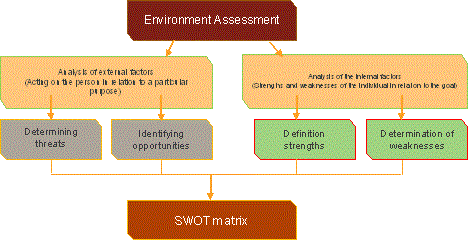
Assess the weaknesses and the strengths of the person in question and also opportunities and threats that the person is facing on his way to achieving his goals. Build the matrix for the SWOT-analysis.
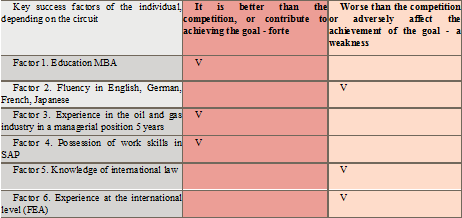
Determine no more than 6-8 key factors in each field in priority order (priority is the degree of impact on the achievement of personal goals). Create a SWOT matrix is for each goal.
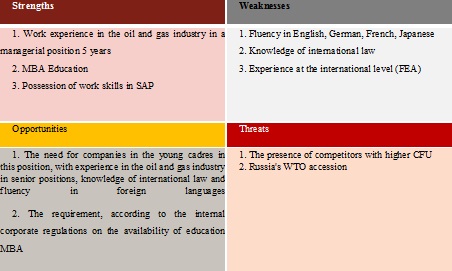
In addition, when doing a SWOT-analysis it is necessary to construct a SWOT matrix, i.e. a table that is divided into squares in which mutual influences of strengths and weaknesses of the individual as well as opportunities and threats of the environment (SO, SU, WO, WT) are placed and for each mutual field actions/measures (strategies) are specified.
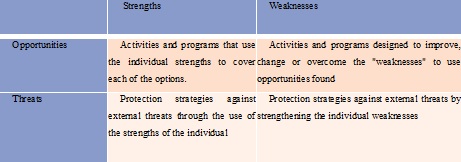
In order to construct the SWOT-analysis matrix for the individual in our example, we need to define key actions-conclusions of the analysis.
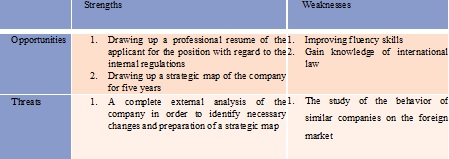
All the actions and programs that are defined in the SWOT matrix constitute a plan of action in priority order, which also shows the deadlines and the necessary resources. These resources could be financial, occupational (training, obtaining new knowledge and skills), etc.
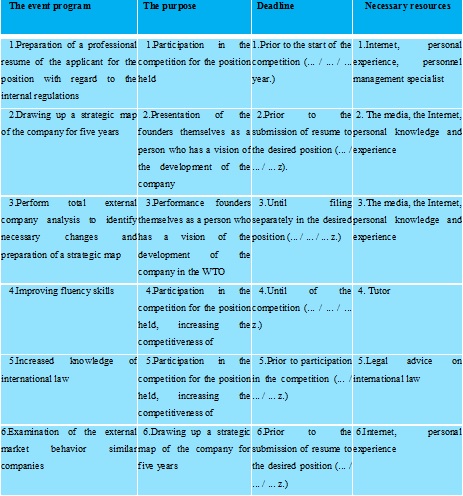
Conclusion
As a result of the above procedures in this study of personal SWOT-analysis, it is possible to conclude that this tool (personal SWOT-analysis) can be used in order to build a strategic personal action plan for achieving any goal. Therefore, it can also be used for achieving a state of well-being, which is in line with the social, physiological, financial and psychological goals of the individual.
References
- Arutunova D.V. (2010). Strategic management. Tutorial. Taganrog: Publishing House of TTI SFU. (in Russian)
- Tokarev V. (2002). Application of the SWOT-analysis in the development of the company's strategy. Acknowledgements Management of the company, 10 (17), 56-60. (in Russian)
Copyright information

This work is licensed under a Creative Commons Attribution-NonCommercial-NoDerivatives 4.0 International License.
About this article
Publication Date
17 January 2017
Article Doi
eBook ISBN
978-1-80296-018-1
Publisher
Future Academy
Volume
19
Print ISBN (optional)
-
Edition Number
1st Edition
Pages
1-776
Subjects
Social welfare, social services, personal health, public health
Cite this article as:
Emiliya, ., Natalia, V., & Oleg, A. (2017). SWOT-Analysis as a Tool to Achieve a State of Personal Well-Being. In F. Casati, G. А. Barysheva, & W. Krieger (Eds.), Lifelong Wellbeing in the World - WELLSO 2016, vol 19. European Proceedings of Social and Behavioural Sciences (pp. 548-553). Future Academy. https://doi.org/10.15405/epsbs.2017.01.74

